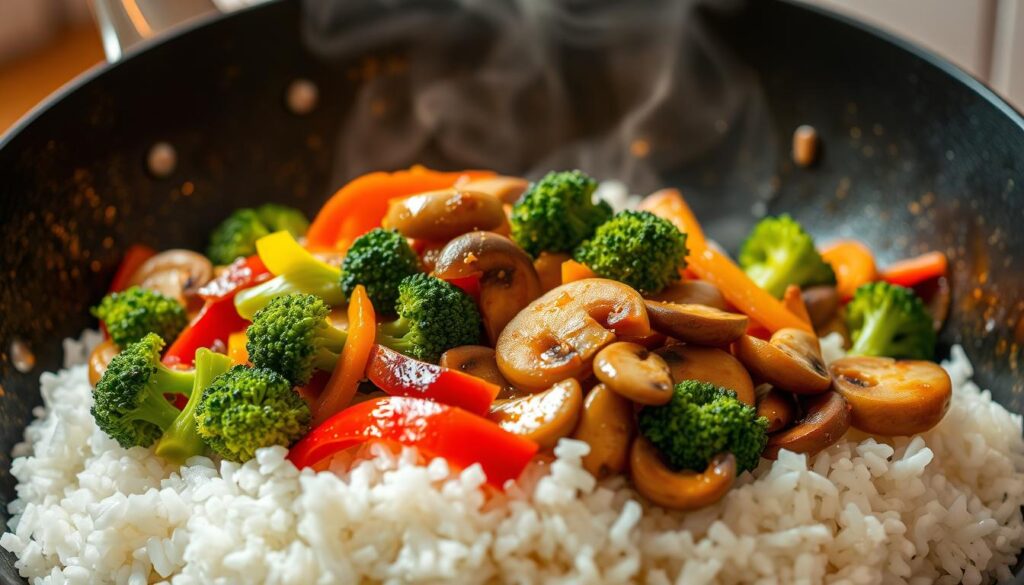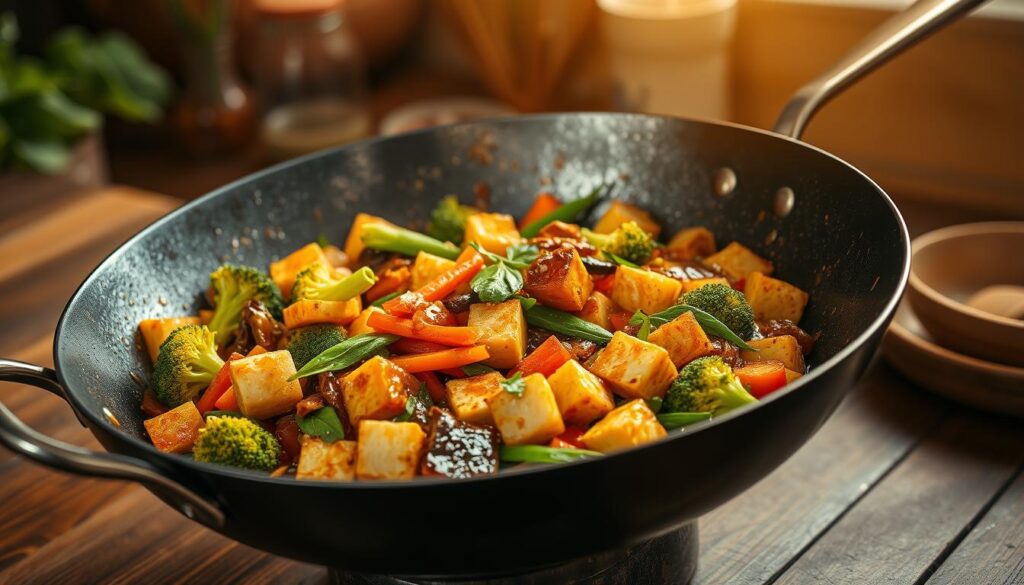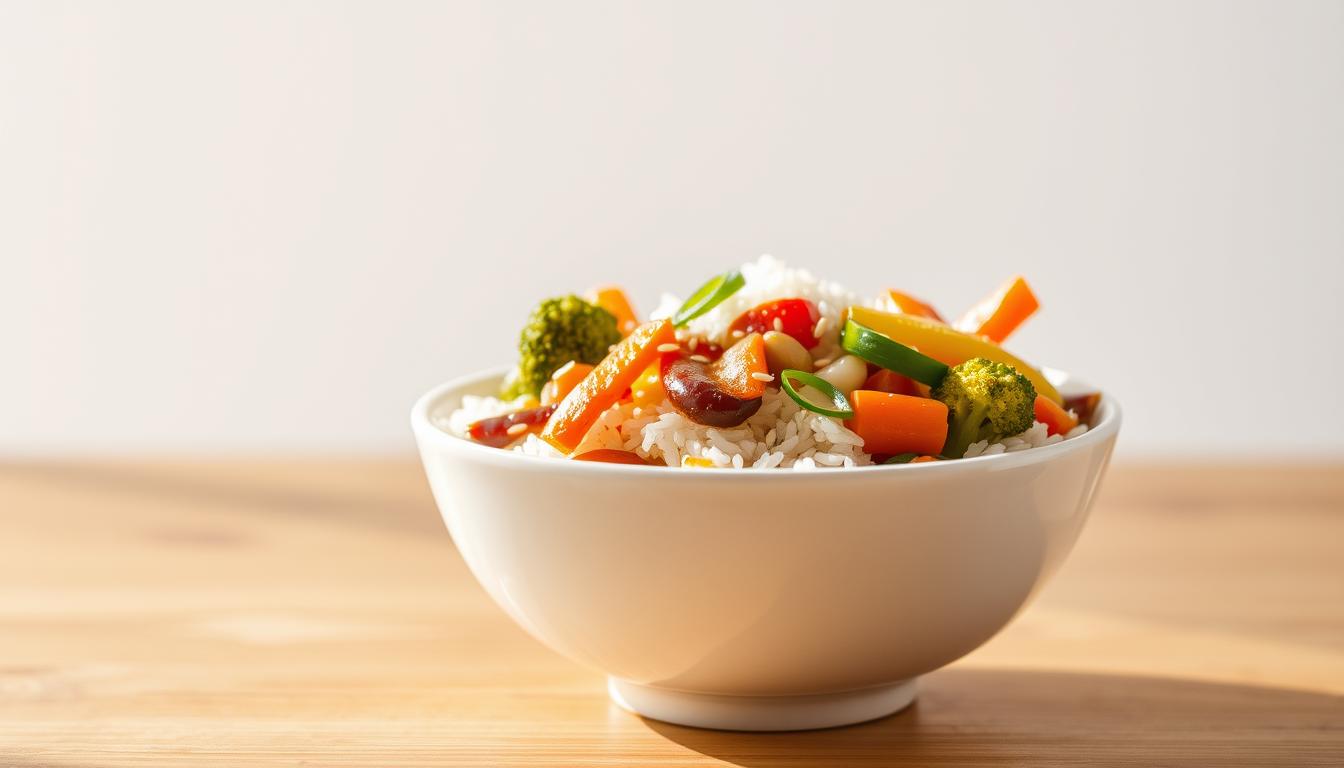Looking for a quick and healthy meal? Veggie Stir-Fry over Rice is a great choice. It’s easy to make and perfect for when you’re in a hurry.
Want to make it even better? Just add your favorite ingredients or try new cooking methods. This way, you can turn a simple healthy rice bowl into a delicious and fulfilling meal.
Key Takeaways
- Learn how to elevate a basic Veggie Stir-Fry over Rice
- Discover simple steps to add flavor and nutrition
- Customize the dish to your taste preferences
- Explore new ingredients and cooking techniques
- Create a healthy and satisfying meal in no time
The Fundamentals of Great Veggie Stir-Fry over Rice
To make your veggie stir-fry stand out, you need to know the basics. A top-notch vegetarian stir-fry comes from fresh ingredients, the right cooking methods, and the perfect mix of flavors.
Key Components of a Successful Stir-Fry
A great stir-fry begins with the right ingredients. Using a variety of fresh and seasonal vegetables boosts the taste, nutrition, and texture of your dish.
- Choose colorful vegetables for visual appeal.
- Mix different textures for a more engaging experience.
- Incorporate aromatic ingredients like garlic and ginger.
Common Pitfalls to Avoid
Even with the best ingredients, a stir-fry can fail if not cooked right. Common mistakes include overcooking the vegetables and not balancing the flavors.
“The key to a great stir-fry is in the balance of flavors and the texture of the vegetables.”
Avoiding these mistakes makes for a quick vegetable stir-fry that’s both tasty and fulfilling. It’s a perfect plant-based meal.

Essential Equipment for Stir-Fry Excellence
To make your homemade stir-fry dish better, you need the right tools.
The right equipment can greatly improve your simple rice stir-fry.
Wok vs. Frying Pan: Making the Right Choice
Choosing between a wok and a frying pan is key for stir-frying.
A wok is best because of its shape. It helps stir ingredients quickly and efficiently.
If you don’t have a wok, a large frying pan works too. Especially if it’s non-stick
Must-Have Tools for Professional Results
Getting professional results in stir-frying needs more than just the right pot.
Heat Management Tools
- A thermometer to keep your pan at the perfect temperature.
- A spatula that can handle high heat.
Cutting and Preparation Equipment
Having the right tools for cutting and preparing is crucial.
- A sharp chef’s knife for clean cuts.
- A cutting board for a stable surface.
Step 1: Selecting Premium Vegetables for Maximum Flavor
The secret to a tasty quick vegetable stir-fry is in the vegetables you pick. Picking the right ones is the first step to a dish that’s both yummy and good-looking.
Seasonal Vegetable Selection Guide
Choosing seasonal veggies makes your vegetarian stir-fry more flavorful. Seasonal produce is fresher and tastes better. Here’s a list of popular seasonal veggies:
| Season | Vegetables |
|---|---|
| Spring | Asparagus, Bell Peppers, Carrots |
| Summer | Zucchini, Corn, Eggplant |
| Autumn | Broccoli, Cauliflower, Mushrooms |
| Winter | Brussels Sprouts, Kale, Sweet Potatoes |
Creating Balanced Texture Combinations
A great healthy rice bowl with stir-fry veggies needs a mix of textures. Mix crunchy veggies like bell peppers and carrots with softer ones like zucchini and mushrooms for a perfect balance.
Proper Cutting Techniques for Even Cooking
To make sure your veggies cook evenly, cut them the same size. Here are some tips:
Julienne and Diagonal Cuts
Julienne cuts are long, thin strips, perfect for carrots and bell peppers. Diagonal cuts are great for veggies like zucchini and green beans, letting them cook more evenly.
Size Consistency Importance
Keeping veggies the same size is key for even cooking. Cut them into similar pieces so they cook at the same time, avoiding some being too raw or too cooked.
By following these tips, you’ll make a delicious and attractive vegetarian stir-fry that goes great with your healthy rice bowl.
Step 2: Mastering the Art of Perfect Rice
Perfectly cooked rice is key for a healthy rice bowl and simple stir-fry. It’s important to know the different rice types and how to cook them right.
Rice Varieties and Their Unique Properties
There are many rice types, each with its own texture and taste. Jasmine rice is known for its sweet smell and softness. Basmati rice, on the other hand, has a nutty taste and is fluffy.
- Jasmine rice: Fragrant and soft
- Basmati rice: Nutty flavor and fluffy
- White rice: Neutral taste and tender
- Brown rice: Nutty flavor and chewy texture
Foolproof Cooking Methods for Different Rice Types
Cooking rice is easy if you know the right way. For white and jasmine rice, a simple water-to-rice ratio works well. Brown rice needs more water and cooks longer.
- Rinse the rice thoroughly before cooking
- Use the appropriate water-to-rice ratio
- Cook on low heat, covered, to prevent moisture loss
The Day-Old Rice Advantage for Stir-Fry
Day-old rice is better for stir-fry. It’s drier, making it easier to stir-fry and giving a better texture.
Proper Cooling and Storage
To use day-old rice, cool it quickly after cooking. Then, store it in an airtight container in the fridge.
Reviving Refrigerated Rice
Before using refrigerated rice for stir-fry, revive it. Sprinkle a little water and heat it in a pan or microwave.
Step 3: Creating Signature Stir-Fry Sauces
Make your easy stir-fry recipe stand out with a unique sauce. The sauce is what makes a stir-fry great, blending the flavors of your veggies and enhancing your meal.
Essential Sauce Components and Ratios
A good stir-fry sauce has a mix of key parts. Knowing these and their ratios helps create a balanced flavor.
- Aromatics (garlic, ginger)
- Acidic component (vinegar, citrus)
- Sweetness source (sugar, honey)
- Savory element (soy sauce, tamari)
- Thickening agent (cornstarch, flour)
The mix of these parts can change based on what you like and the stir-fry type. A good start is 2 parts savory, 1 part sweet, and 1 part acidic.
| Component | Example Ingredients | Ratio |
|---|---|---|
| Aromatics | Garlic, Ginger | Variable |
| Acidic | Vinegar, Citrus Juice | 1 part |
| Sweetness | Sugar, Honey | 1 part |
| Savory | Soy Sauce, Tamari | 2 parts |
Balancing Sweet, Salty, Sour, and Umami Flavors
Getting the right mix of sweet, salty, sour, and umami is key. Umami adds depth and makes the dish richer.
“The balance of flavors is the key to a great sauce. Too much of any one flavor can throw off the entire dish.”
Regional Asian Sauce Variations
Asian cuisines have their own stir-fry sauce styles. Exploring these can help you create your own unique sauce.
Chinese-Inspired Classics
Chinese stir-fries often use soy sauce, oyster sauce (or mushroom sauce for vegetarians), and hoisin sauce.
Thai and Vietnamese Flavor Profiles
Thai stir-fries mix fish sauce, lime juice, and chili peppers for a spicy kick. Vietnamese dishes might use fish sauce, lime juice, and herbs like basil or mint.
By trying out these regional flavors, you can craft a stir-fry sauce that’s truly yours.
Step 4: Mastering Professional Stir-Frying Techniques
To make a great veggie stir-fry over rice, you need to master stir-frying techniques. This step is key to balancing flavors and textures. It’s a mix of science and art.
The Science of High-Heat Cooking
High-heat cooking is vital for a stir-fry’s ‘wok hei’ or ‘breath of the wok’. It cooks ingredients quickly, keeping them crunchy and colorful. High-heat cooking also seals in flavors and nutrients.
Proper Ingredient Sequencing for Perfect Doneness
The order of adding ingredients is crucial for perfect doneness. Start with aromatics like garlic and ginger. Then add proteins, followed by vegetables, based on their cooking times.
| Ingredient Type | Cooking Time |
|---|---|
| Aromatics | 1-2 minutes |
| Proteins | 3-5 minutes |
| Vegetables | 2-4 minutes |
Wok Movement: Tossing vs. Stirring Techniques
The way you move your wok affects your stir-fry. Tossing works for big batches, while stirring is better for small amounts. Both methods spread heat and prevent sticking.
Preventing Overcrowding
Overcrowding can make your stir-fry steam instead of stir-fry. Cook in batches if needed. This ensures even cooking for each ingredient.
Managing Steam and Moisture
Controlling steam and moisture is key for a perfect stir-fry. Adjust the heat, use the right oil, and don’t overload the wok.
Step 5: Incorporating Protein into Your Veggie Stir-Fry over Rice
Add the right plant-based protein to your veggie stir-fry. This boosts the meal’s nutrition and makes it more filling.
Plant-Based Protein Options and Preparation

There are many plant-based proteins to choose from. Tofu, tempeh, and seitan are great because they soak up flavors well. Tofu, for example, can be marinated and then pan-fried or baked before adding it to your stir-fry.
Legumes like chickpeas and lentils are also good. They can be cooked first and then added to your stir-fry. Nuts and seeds, such as almonds and chia seeds, also add protein.
Marinating Techniques for Professional Results
Marinating your protein before cooking makes it taste better. A good marinade has soy sauce, garlic, ginger, and maple syrup. For tempeh, marinating it longer makes it tender and flavorful.
Strategic Cooking: Separate vs. Combined Methods
Cooking your protein separately ensures it’s perfectly done. But, you can also cook it with your vegetables if you adjust the cooking time and method.
Timing Considerations
Timing is crucial when combining protein with vegetables. Add your protein towards the end to avoid overcooking.
Texture Preservation Strategies
To keep your protein’s texture, don’t overcook it. Press tofu before cooking to get a crispy outside.
By using these tips, you can make a vegetarian stir-fry that’s tasty and full of protein. It’s a healthy and satisfying meal.
Step 6: Adding Finishing Touches That Transform Your Dish
Turning a simple veggie stir-fry into a gourmet meal is all about the finishing touches. These final additions can greatly improve the flavor, texture, and look of your dish.
Strategic Garnishes for Flavor and Visual Appeal
Garnishes do more than just look good; they add flavor to your stir-fry. Try using fresh herbs like cilantro, basil, or scallions for a burst of color and freshness. For a quick and tasty stir-fry, add toasted sesame seeds or chopped nuts for texture and flavor.
Textural Elements That Elevate the Experience
Adding different textures can make your meal more enjoyable. Try adding crunchy elements like toasted peanuts or crispy fried shallots to your stir-fry. For a homemade dish, crispy fried wonton strips can add a nice crunch.
Final Seasoning Adjustments and Flavor Boosters
Seasoning your stir-fry at the end is key to bringing all the flavors together. Taste it and adjust the seasoning as needed. Use soy sauce, fish sauce, or oyster sauce (for non-vegetarian options) to deepen the flavors.
Fresh Herbs and Aromatics
Fresh herbs like mint, basil, and cilantro add a bright, fresh taste. Aromatics like garlic, ginger, and shallots can be used to make a flavorful oil or as a garnish.
Specialty Oils and Condiments
Specialty oils like sesame oil or chili oil can add a unique flavor. Condiments such as sriracha or furikake can also add an extra layer of taste.
| Garnish/Element | Flavor Profile | Texture |
|---|---|---|
| Fresh Cilantro | Fresh, herbal | Soft |
| Toasted Sesame Seeds | Nutty | Crunchy |
| Crispy Fried Shallots | Sweet, savory | Crunchy |
Nutritional Benefits of Balanced Veggie Stir-Fry Meals
Stir-fry meals are packed with nutrients, offering a mix of important vitamins and minerals. They can be a healthy rice bowl that combines veggies, lean proteins, and whole grains. This mix is great for your health.
Macronutrient Composition and Balance
A good stir-fry has carbs from rice and veggies, proteins from tofu or lean meats, and fats from oils and nuts. This balance keeps your energy up and supports your health.
Micronutrients, Antioxidants, and Health Benefits
Stir-fry veggies are full of vitamins, minerals, and antioxidants. Bell peppers have vitamin C, and leafy greens offer iron and calcium. These nutrients boost your immune system, eye health, and bone strength.
Adapting Recipes for Specific Dietary Needs
Stir-fry recipes can be changed to fit any diet, like a plant-based meal or special dietary needs. You can swap out ingredients for gluten-free, vegan, or low-carb options. This makes stir-fry meals flexible for everyone.
Troubleshooting Common Stir-Fry Challenges
Even experienced cooks face challenges when making a veggie stir-fry over rice. But, with the right techniques, you can solve common problems. This section will help you fix texture, flavor, and burning issues to get a perfect dish.
Addressing Texture Issues: Soggy vs. Crisp Vegetables
Texture is key in a good veggie stir-fry. Soggy veggies come from overcooking or not drying them well after washing. To get crisp veggies, cook them quickly and at the right temperature.
| Cause | Effect | Solution |
|---|---|---|
| Overcooking | Soggy vegetables | Cook vegetables briefly |
| Inadequate drying | Soggy vegetables | Dry vegetables thoroughly after washing |
| Incorrect temperature | Crisp or soggy vegetables | Use high heat for quick cooking |
Flavor Enhancement for Bland Results
A bland veggie stir-fry can be made better with sauces, herbs, and spices. Chef
“The key to a great stir-fry is in the sauce”
points out the importance of a balanced sauce.
Preventing Burning and Sticking Problems
Temperature Control Solutions
Keeping the right temperature is key to avoid burning and sticking. Make sure your wok or pan is hot before adding ingredients.
Oil Selection and Usage
The right oil helps prevent sticking and burning. Use an oil with a high smoke point, like peanut or avocado oil, and use it sparingly.
Meal Prep Strategies for Weeknight Stir-Fry Success
With the right meal prep strategies, weeknight dinners can be stress-free and tasty. Meal prep is key to enjoying a home-cooked meal without hassle, especially on busy nights.
Components to Prepare in Advance
Preparing some parts ahead can make cooking easier.
- Chop vegetables and store them in airtight containers.
- Cook rice and proteins ahead of time.
- Prepare stir-fry sauces and store them in the refrigerator.
Storage Solutions for Prepped Ingredients
Proper storage keeps prepped ingredients fresh and quality.
- Use airtight containers to store chopped vegetables and cooked rice.
- Label containers with dates to ensure you use the oldest items first.
Efficient Assembly and Cooking Workflow
An efficient workflow makes cooking stress-free.
Time-Saving Techniques
- Cook proteins and vegetables in bulk.
- Use a “cook once, eat twice” strategy for ingredients.
Maintaining Quality in Make-Ahead Components
- Regularly check prepped ingredients for freshness.
- Reheat ingredients properly before assembling the dish.
By using these meal prep strategies, you can enjoy a delicious easy stir-fry recipe on a busy weeknight.
“The best cooking is always done with love, and the best meal prep is done with planning.”
Effective meal prep saves time and makes cooking better.
From Basic to Gourmet: Future Directions for Your Stir-Fry Journey
Once you get good at making veggie stir-fry over rice, you’ll want to try new things. Start by adding unique ingredients and flavors to your stir-fries. This will help you make your dishes even more special.
Try using different vegetables like exotic mushrooms or colorful bell peppers. These can add interesting textures and tastes to your meals. Also, look into stir-fry recipes from other places, like Korean bibimbap or Thai basil stir-fry. They can introduce you to new flavors.
The internet is full of ideas for stir-fry lovers. You can find many recipes and cooking tips online. By exploring these, you’ll keep improving your cooking skills. Soon, you’ll be making your own gourmet veggie stir-fry over rice dishes.

